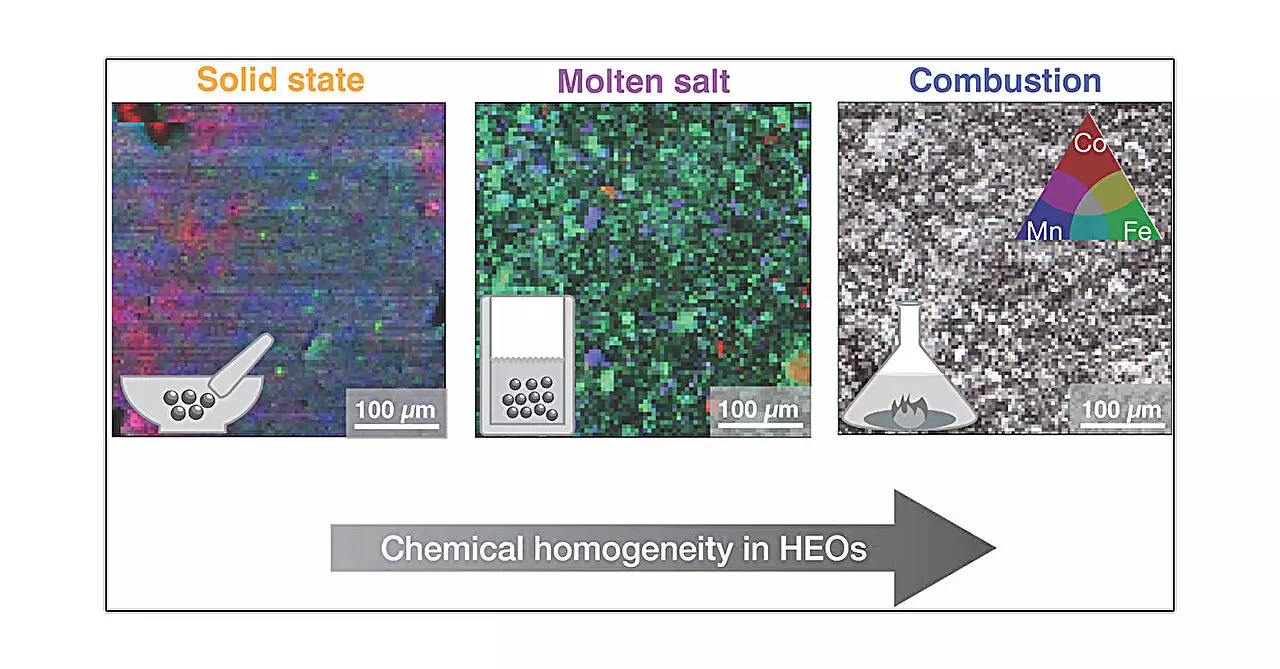High entropy oxides have garnered substantial interest in materials science due to their unique properties and diverse applications, particularly in the realm of electronics. A groundbreaking study recently published in the *Journal of the American Chemical Society* sheds new light on how various synthesis methods can significantly influence the structural and functional characteristics of these materials. This research offers a fascinating glimpse into the flexible nature of high entropy oxides, especially as they are crafted for innovative uses.
High entropy oxides are distinguished by their intricate compositions, often consisting of five or more different transition metal oxides blended together. This complexity not only contributes to their intriguing properties but also their versatility in technological applications. According to Alannah Hallas, a prominent materials scientist at the University of British Columbia’s Blusson Quantum Matter Institute, these materials exhibit remarkable electrochemical performance, making them prime candidates for advancements in electronic devices. The study emphasizes the importance of synthesis methods, which serve as the building blocks for producing these remarkable materials.
The core of the research revolves around the examination of five distinct synthesis methodologies: solid-state synthesis, high-pressure synthesis, hydrothermal synthesis, molten salt synthesis, and combustion synthesis. Each method represents a unique approach to material formation, characterized by different heating protocols, cooling rates, and chemical environments. Interestingly, while the average structure of the produced high entropy oxides remained consistent across the different methods, the local structures and microstructures varied significantly based on the synthesis technique used.
The lead author, Mario Ulises Gonzáles-Rivas, skillfully describes the nuances of each method. In solid-state synthesis, for instance, the process resembles baking, where metal oxides are uniformly mixed and heated to create a stable compound. High-pressure synthesis introduces external pressure during heating, offering a means to influence the material’s density and structural integrity. The hydrothermal technique involves using pressurized water to mimic the natural conditions under which minerals form, allowing for orderly crystal growth. Molten salt synthesis, on the other hand, capitalizes on high-temperature liquid salts that precipitate crystals as they cool. Lastly, combustion synthesis rapidly produces materials by igniting a gel formed from metal salts, generating heat through the combustion reaction to form the high entropy oxide quickly.
Insights from the Study
The substantial differences observed in local structures and microstructures emphasize the critical role of synthesis methods. As Gonzáles-Rivas points out, these structural variations are not merely academic; they have real-world implications for the materials’ functionality in energy systems. By demonstrating that each synthesis method can yield materials with distinct properties, this research opens doors for the optimization of high entropy oxides tailored for specific applications.
One notable finding from the study is that combustion synthesis results in the most uniform and homogeneous samples. This characteristic could enhance the performance and reliability of devices utilizing these materials, particularly in energy-related applications such as batteries and fuel cells. Therefore, understanding how to manipulate synthesis methods paves the way for developing high-performance materials that can potentially tackle the pressing energy challenges of our time.
This research exemplifies the power of collaboration in science, with contributions from Hallas’s team at UBC, Robert Green from the University of Saskatchewan, and Hidenori Takagi from the Max Planck Institute for Solid State Research. Their collective expertise underscores the multidisciplinary nature of material science, where chemistry, physics, and engineering intersect. Moving forward, the findings from this study provide a foundation for future research aimed at exploiting the vast potential of high entropy oxides.
As researchers continue to explore the myriad possibilities of high entropy oxides, it is clear that the synthesis method employed holds significant implications for the resulting material properties. With a newfound understanding of how synthesis impacts functionality, the path toward innovative applications in electronics and energy systems looks promising. By fine-tuning the synthesis processes, it may soon be possible to design high entropy oxides that not only meet current technological demands but also drive future advancements.


Leave a Reply